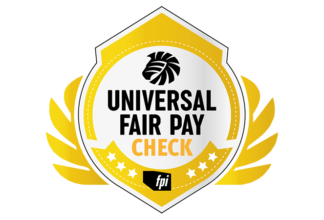Fair Pay Around the World
International Equal Pay Day on September 18, 2021
September 18, 2021, is International Equal Pay Day. This year, the Equal Pay International Coalition (EPIC) invites you to discuss why global pay equality is so important to effectively combat the pandemic. But what kind of laws are in place in different countries? How are national pay gap statistics actually measured? And what needs to happen to ensure that women are not fully or partially excluded from the labor market anywhere in the world? Henrike von Platen wrote about this in her recently published book. Read an excerpt here.
We don't need a quota,
we need equal pay.
Tim Cook, CEO, Apple
To calculate the statistical pay gap, different countries collect different data and interpret it differently. In Germany, the comparison always refers to the average gross hourly earnings of men and women. What is not taken into account in the statistics and cannot be represented are the unpaid hours of work that women, in particular, perform in the family and in the household – the so-called unpaid care work, which is one of the main causes of the earnings gap.
To close this gap in the pay gap statistics, the Statistical Office of the European Union, or Eurostat, calculates the so-called Gender Overall Earnings Gap: Here, gross hourly wages are also compared. In addition, the overall labor market participation rate and the number of men and women working in a country are examined. Taken together, the average values for occupation, weekly working hours, and gross hourly wages provide a much more accurate picture of the actual situation.
European conditions: Italy & Germany
Take Italy, for example: The country has a remarkably small wage gap of just 5 percent, making it one of the lowest gender pay gaps in Europe. Yet the distribution of roles in families is usually very traditional, and there are also special reconciliation challenges such as the long summer vacations: Schools close for three months over the summer, and vacation care is hardly ever offered. In Italy, the man usually goes to work, while the woman takes care of the household and the children. The fact that the Italian wage gap is still so small is therefore not due to the division of employment and family work between the partners, but rather to the fact that women usually stop working as soon as they become pregnant and therefore no longer appear in any statistics. For a long time, it was common practice in Italy – against current European law – to hand women their notice of termination in the event of pregnancy along with their employment contract. In addition, men usually work full time, while women – if they work at all – are employed for a much smaller number of hours. So, all of this is accounted for in the European Statistical Office's calculation. The Gender Overall Earnings Gap turns out to be as high for Italy as social circumstances would suggest: in 2014, the difference was 43.7 percent.
Germany, on the other hand, fares even worse than Italy in the European statistics: 45.2 percent Gender Overall Earnings Gap, and thus well below the European average despite all equality efforts. Thus, the labor market participation of women and men in Germany is comparatively high. But the gender pay gap is also one of the highest in Europe. The reason: nowhere in Europe are as many women employed part-time as in Germany - almost every second woman works part-time, but only every tenth man. The average number of hours worked per week in 2017 was 38.9 for men and 30.5 for women.
Complicated calculation methods: from average to median
Germany fares a little better with the Organization for Economic Cooperation and Development, achieving a value in the upper midfield in the OECD ranking of 16 percent. The data is collected for all 36 member states, but unlike the Federal Statistical Office for Germany and Eurostat for Europe, the wage gap is calculated using the median rather than the average. If the EU calculates with the sum of all salaries divided by the number of employees, the OECD determines the median value, which is exactly in the middle of the highest and the lowest value within a salary group – which can be a completely different result. The OECD also calculates full-time equivalents; part-time salaries are extrapolated to full-time. And to make the confusion of terms perfect, the resulting value is called the Gender Wage Gap. The OECD ranking is led by South Korea with 34.6 percent. Japan is in third place with a value of 24.5 percent. In both countries, there is a strong disparity between men and women in the labor markets in almost all industries and professions. Men dominate engineering, skilled trades, and manufacturing, while women dominate social occupations (horizontal segregation), and the proportion of women in management positions remains low (vertical segregation). However, in both Japan and South Korea, women are catching up – better education and greater labor market participation are evident. Both countries feel compelled by demographic trends to rapidly advance equality: Society is aging. No other country in the world has as many older people as Japan. While the birth rate is falling, a quarter of the population is over 65 years old – sales of adult incontinence diapers now exceed those of baby diapers. Women are urgently needed as a workforce.
A comparison of OECD and Eurostat data shows that the median in Germany is much lower than the average. This means that higher salaries - which are more often received by men - thus have a major impact on the gap. In the calculation, they influence the median upward and, compared to the average, show how asymmetrical the level of salaries actually is.
The UK also calculates the national pay gap using the median rather than the average. In Australia and New Zealand, income gaps are reported in terms of weekly and monthly salaries. In some countries, certain industries are not included, or companies are only included if they have more than ten employees.
Confusion of terms
Gender pay gap, gender overall earnings gap, gender wage gap – when it comes to fair pay, there are not only very different calculation methods and databases, averages and medians, but also a whole host of terms that are not easy to distinguish either at first or second glance. It is therefore very difficult to quantify a global gender pay gap or to define a global Equal Pay Day.
But closing the gender pay gap is a global concern. Unlike in Germany, however, in most countries, it is not the employees who are held accountable, but the companies themselves. And in an increasing number of countries, companies face fines if they fail to meet the requirements – a notoriously effective way of accelerating development.
Stricter laws in Iceland, the UK, France, and Switzerland
Nowhere else in the world are there such ambitious plans on pay equity as in Iceland: Equality on the payslip by 2022 is the Icelandic government's goal. Also in the UK ((link)), companies with more than 250 employees are required to publish the company's internal gender pay gap, first on the UK government's website, and second on the company's own website. As a result of the public naming and shaming, many companies use the publication of their figures as an opportunity to also present new equality strategies in parallel.
Legislation has also been tightened in France. Companies with more than 50 employees must calculate their Gender Equality Index: Pay gaps, salary increases, promotion opportunities, return from parental leave and the proportion of women in the ten best-paid positions in the company – each of these five criteria is assigned a point value. A maximum value of 100 points can be achieved. If a company's performance falls below 75 points, fines can be imposed. Only three companies achieved near-perfect scores of 99 points in 2019: the catering company Sodexo and the two insurance giants MAIF and CNP Assurances. The 118 companies that wrote red Gender Equality numbers were asked to submit a plan to address the inequalities in their pay system – and to implement it immediately.
And in the neighboring country in Switzerland, things are also supposed to move faster. Since summer 2020, a new equality law is supposed to ensure better enforcement of fair pay: companies with 100 or more employees are given a deadline to review their pay structures. They had to conduct a pay analysis by summer 2021 at the latest and will now have to repeat the analysis every four years.
"Because it's 2015!": Australia, Canada, and the rest of the world
In Australia, too – like the UK – companies with more than 100 employees are required to produce an annual report on equality in the company, which covers many other equality data in addition to gender pay gap figures: How is gender distributed across the workforce and hierarchy levels? Are flexible working hours possible? What reconciliation measures does the company offer? The results are published and can be viewed by everyone on the website of the Workplace Gender Equality Agency. There, the data is also analyzed centrally and best practice examples from everyday company life are highlighted.
Canada, on the other hand, is also living up to its progressive reputation when it comes to fair pay. The Canadian Ministry of Equal Opportunity is working across the country, but individual states, especially Ontario and Québec, are also working on new laws that are being developed in close cooperation with business and trade unions. The plan: Canadian companies are to calculate the company-internal gender pay gap and publish it on a specially created web portal. The aim is to raise awareness of the pay gap. There is still a lot of work to be done, as Prime Minister Justin Trudeau found when he famously said, "Because it's 2015!" upon taking office that his cabinet should be made up of 15 female ministers and 15 male ministers. In his keynote address at the World Economic Forum 2018, the feminist prime minister was at the same time convinced that equality and economic growth are inseparable: "Every leader can shape change themselves immediately ... Every leader can hire, promote, and retain women – not because it's the right thing to do or because it's nice to do, but because it's the smartest thing leaders can do."
The Canadian prime minister is by no means alone in this conviction - all over the world, politicians are setting a clear course for business with new equal pay laws - even across countries. The Canadian Pay Equity Act came into force on August 31, 2021.
Equal pay: not a free exercise, but a duty
But even though the situation is already good or very good in some countries in Northern Europe, especially in the Scandinavian states, in North America, or Australia, gender equality has not yet been achieved in a single country in the world. Yet the equal treatment of men and women is enshrined in international law, in the German constitution, in European law, and in many other laws around the world. In other words, as in Germany, equal pay is not a free exercise but a duty in the vast majority of countries around the world. In 2019, the organization Equal Measures was unable to give a single country an "excellent" report card in terms of gender equality: To date, four out of five women and girls live in countries where gender equality is "poor" or "very poor."
Equal opportunities for all
Gender equality was therefore not only set as goal number 5 of the 17 UN Sustainable Development Goals. It is also the most important cross-cutting theme of all the goals and the basis for all other UN Sustainable Development Goals. In a nutshell: Only when women and men succeed in achieving equality hunger, violence, and other ills can also be ended. To achieve equality, the first step is the economic independence of women. And to achieve this, the very first step is equal pay.
The demand for equal pay means more than "just" closing the gender pay gap. Because in addition to the pay gap between men and women, there are also differences in the pay of people of different ages, different origins, or pay discrimination against people with disabilities. In fact, other forms of pay discrimination don't stand a chance in companies that have a very small gender pay gap or none – once you analyze and clean up your structures, you pay everyone fairly. And ultimately creates equal opportunities for everyone. With all the consequences. In other words, paying fairly means ending wars and saving polar bears. And most international players now know this.
As a result, more and more international organizations are joining forces to bundle the many regional and national initiatives, network across all borders, exchange solutions, and achieve more by working together.
Tailwind from politics
All the new alliances and laws have far-reaching consequences - and clear legislation can accelerate development immensely. Landsbanki Íslands, for example, calculated that the equivalent of about 120,000 euros had to be invested to meet all the new legal requirements. "If the law didn't force us, we would continue as we are and the wage gap would still not be closed in ten years," says Baldur Jonsson, Human Resources Manager at Iceland's leading financial institution. Yet the investment is relatively small – cloud computing provider Salesforce invested a few million dollars, and without the pressure of fearing sanctions. Barack Obama already launched an Equal Pay Memorandum of Understanding during his time in office, which was signed by more than 100 companies, including Adobe, Apple, Facebook, Intel, and Salesforce. In California, another large group of companies voluntarily joined together in 2019 to push for more equal pay in the tech industry, also including Salesforce and Apple.
Holding companies accountable that don't want to on their own is a smart and forward-thinking decision. No country in the world and no company will be able to afford to exclude women from the labor market in whole or in part in the future.
With kind permission of the publisher Nicolai Publishing & Intelligence GmbH. This text is a highly abridged excerpt from the chapter "Fair Pay Around the World - Worldwide Transparency Course of Politics" in Henrike von Platen's book "Talking about money - the fast track to equality". The book was published in 2020 in the series "Economies of the Future" by Nicolai Verlag:
Hardcover
168 pages, 12.5 x 19.5 cm
ISBN 978-3-96476-031-9
also available as e-book
18,00€ incl. VAT.
Universal Fair pay Check
Entgeltgleichheit leicht gemacht: Unabhängig von der Beschäftigtenzahl, dem Standort, der Organisationsform und der jeweiligeen Gesetzgebung. In jedem Unternehmen weltweit.
MEHR LESEN
Unternehmen
Das Wissen um die Lohnlücke, gepaart mit dem guten Willen, den Missstand aus der Welt zu schaffen, reicht offenbar nicht aus, um auch tatsächlich für faire Bezahlung zu sorgen ...
MEHR LESEN
Best Practice wanted
Wir sind der festen Überzeugung, dass Lohngerechtigkeit schon morgen möglich wäre – wenn alle sie wollten. Das zeigen gerade jene Unternehmen, in denen es schon jetzt fair(er) zugeht.
MEHR LESEN




